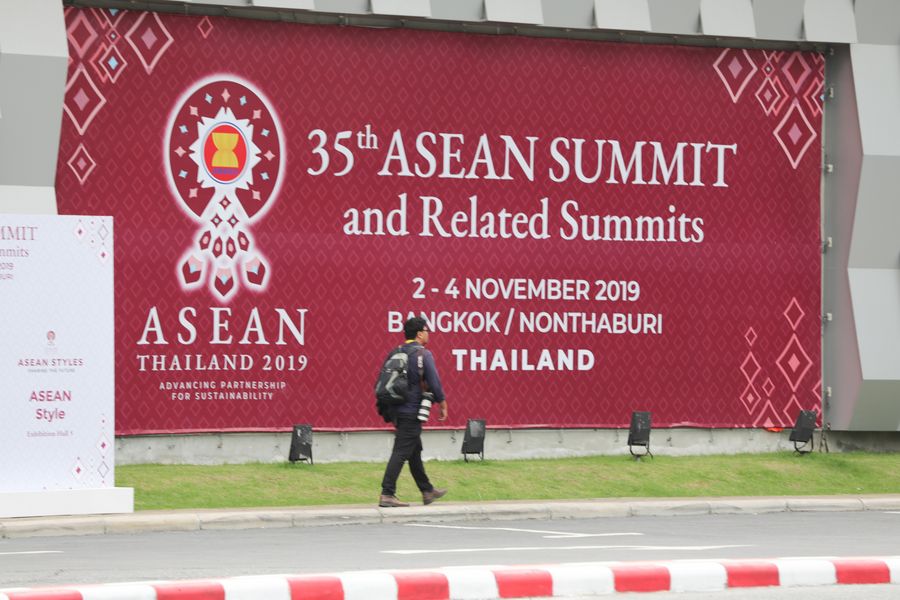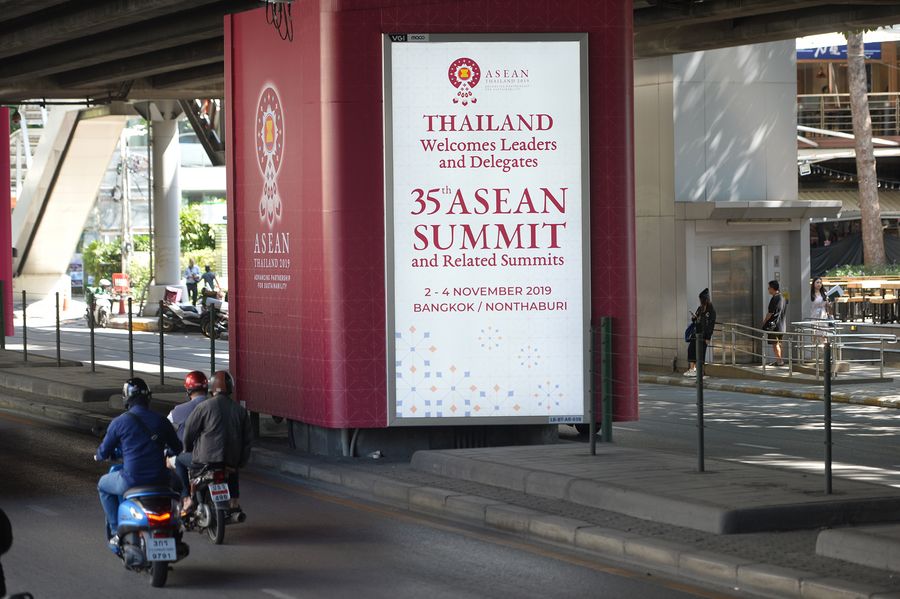
A man passes by a poster of the 35th ASEAN summit and related summits in Bangkok, Thailand, Nov. 1, 2019. (Xinhua/Zhang Keren)
Officials from China and ASEAN have repeatedly noted that China-ASEAN relations have entered a new stage of all-round development.
Both sides have shown deeper mutual trust, have developed closer economic and trade cooperation, have been working together to pursue comprehensive connectivity from infrastructure to people, and have been standing side by side in regional and global affairs.
BANGKOK, Nov. 1 (Xinhua) -- This year marks the 28th anniversary of the dialogue relationship between China and the Association of Southeast Asian Nations (ASEAN) and the 16th anniversary of their strategic partnership. Officials from both sides have repeatedly noted that China-ASEAN relations have entered a new stage of all-round development.
DEEPER MUTUAL TRUST
Leaders of both sides have shown deeper strategic mutual trust and their commitment to a long-term close relationship. Last year, the China-ASEAN Strategic Partnership Vision 2030 was adopted at the China-ASEAN Summit in Singapore, drawing a blueprint for the medium and long-term development of bilateral ties.
Frequent exchanges between leaders of both sides have been maintained. Leaders of the 10 ASEAN countries and the ASEAN Secretariat attended the Second Belt and Road Forum for International Cooperation in Beijing this April. At the forum, Chinese President Xi Jinping proposed building a closer China-ASEAN community with a shared future.
Jointly committed to safeguarding peace and stability in the South China Sea, the two sides in July finished the first reading of the Single Draft Negotiating Text of the Code of Conduct (COC) in the South China Sea ahead of schedule, marking a major progress in the COC consultations.
The early completion of the reading is "an important step toward the goal of concluding the consultations within three years," said Chinese State Councilor and Foreign Minister Wang Yi while announcing the progress, attributing the achievement to the "sincerity and resolve of all parties."
Both are also exploring joint maritime exercises and a mechanism for a defense chiefs' meeting, as well as expanding exchanges and cooperation in military security and law enforcement to tackle regional security challenges, Chinese ambassador to ASEAN Huang Xilian told Xinhua ahead of the 22nd China-ASEAN summit scheduled for Nov. 3 in Bangkok, Thailand.
CLOSER ECONOMIC, TRADE COOPERATION
Against the backdrop of sluggish global growth and rising trade protectionism, ASEAN-China trade volume reached a record high of 587.8 billion U.S. dollars in 2018, with a growth rate of 14.1 percent year-on-year. In the first half of 2019, landmark progress was achieved, with ASEAN overtaking the United States to become China's second-largest trading partner.
Trade volume reached 291.85 billion U.S. dollars in the first six months of 2019 and is expected to exceed 600 billion by the end of the year, statistics from the Chinese Ministry of Commerce show.
Cooperation in emerging industries is accelerating as well, including in digital economy, e-commerce, smart city and 5G. The two sides have agreed to designate next year as the Year of the China-ASEAN Digital Economy, offering an opportunity to expand cooperation in these areas.
Growing economic interdependence between China and ASEAN has become the cornerstone of long-term peace and shared prosperity in the region, Chheang Vannarith, president of the Asian Vision Institute in Cambodia, opined.
"Against the backdrop of rising protectionism and unilateralism, China and ASEAN are compelled to deepen their economic integration and advance inclusive, open, effective and rules-based multilateral system," he told Xinhua in a recent interview.
COMPREHENSIVE CONNECTIVITY FROM INFRASTRUCTURE TO PEOPLE
The two sides have been working together to pursue comprehensive connectivity in various spheres, from infrastructure to policy, trade, information and people.

People pass by a poster of the 35th ASEAN summit and related summits in Bangkok, Thailand, Oct. 30, 2019. (Xinhua/Rachen Sageamsak)
A joint statement on dovetailing China's Belt and Road Initiative (BRI) with the Master Plan on ASEAN Connectivity 2025 is expected to be adopted during the upcoming ASEAN-China summit in Bangkok, as a major step forward in boosting the connectivity and communication between China and ASEAN.
"Joining hands between ASEAN Connectivity Master Plan and BRI, is definitely a positive factor that will expedite the implementation of infrastructure development and translate plan into reality sooner," said Mey Kalyan, chairman of the Cambodia Development Resource Institute.
"All these will foster inclusive economic development in the region, and as a result, will certainly make people more prosperous," he told Xinhua.
Major BRI projects have been launched one after another. Initial progress was made in the China-Singapore New International Land-Sea Trade Corridor. The Jakarta-Bandung high-speed rail, the China-Laos railway and the light rail project in Hanoi are advancing steadily. Construction has started on the expressway from Phnom Penh to Sihanoukville and on phase II of the Thailand-China railway that links Nakhon Ratchasima with Nong Khai, to name just a few, according to Ambassador Huang.
Apart from infrastructure connectivity, China and ASEAN are also working together to expand communications in policy, trade, finance and people-to-people exchanges. China remains ASEAN's largest source of tourists, and more and more people from ASEAN countries are working or studying in China. The ASEAN-China Young Leaders Scholarship was established this year to enhance friendship, communication and mutual understanding among the peoples of China and ASEAN, especially the young generation.
CLOSER COORDINATION IN REGIONAL, GLOBAL AFFAIRS
China and ASEAN have been standing side by side to reject protectionism and unilateralism, push forward the negotiations of the Regional Comprehensive Economic Partnership Agreement (RCEP) and jointly uphold a rules-based multilateral trading regime.
As important participants and beneficiaries of the multilateral trading regime, China and ASEAN countries recognize their responsibility and obligation to jointly uphold free trade and multilateralism. They have shown indomitable determination and at the same time flexibility to push for the early conclusion of the RCEP negotiations, a powerful tool to combat the rising protectionism and unilateralism.
China and ASEAN share the common values of openness, inclusiveness and mutual learning between civilizations and are committed to closer regional integration and maintaining regional peace and stability. In 2018, both sides set up the Jakarta Channel, a multilateral cooperation platform for East Asia centered on ASEAN, and Jakarta Forum, both of which have played important role in facilitating bilateral and East Asian communications and addressing hotspot issues for regional peace and stability.
Both sides have also promoted subregional cooperation, including Lancang-Mekong cooperation and Brunei, Indonesia, Malaysia and the Philippines-East ASEAN Growth Area (BIMP-EAGA)-China cooperation.
"Great strides forward have been made when it comes to the cooperation between China and ASEAN," Joseph Matthews, a senior professor at the BELTEI International University in Phnom Penh, told Xinhua.
"There is still room for further cooperation and exploration between China-ASEAN in the areas of education, human resources development, transfer of technology, medical science and agriculture sector, etc," he said. These are the areas where both sides can work more closely and strategically for the mutual benefits of the people of both sides, Matthews suggested. ■



